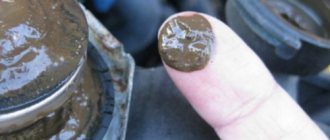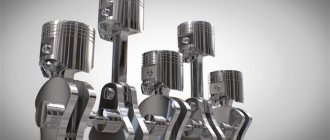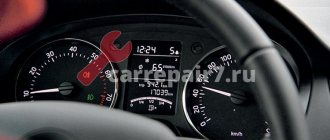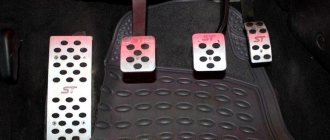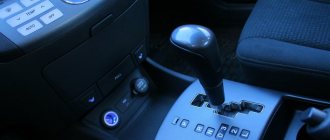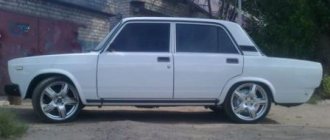Table of contents
- When to use
- How to brake correctly with ABS
- How to brake correctly without ABS
- Sports braking
- Impulse braking
- Measured braking
- Skidding
- Let's summarize
Correct technique can only be achieved through persistent training. The Anton Zakharov Racing Academy trains beginners and professionals. We have driving courses for children, women, and licensed drivers who want to regain their skills. After completing the courses, you will learn to cope with any situation on the road.
Should I depress the clutch pedal?
Another important question: should you depress the clutch pedal when braking with ABS and a manual transmission? The instructions for foreign cars say to “squeeze.” In general, this is not so important. The only difference is that when braking with the gear engaged, you need to press the brake harder to achieve maximum deceleration than when the clutch pedal is depressed. But believe me, the brakes are so strong that they will do the job in both cases. So whether you press the clutch is up to you, but you should know all the pros and cons of both braking methods. And they are next.
Breaking driving patterns is not good...
If in everyday driving you are used to braking in a gear without depressing the clutch pedal (which is very correct!), then depressing it during emergency braking means doing an unnecessary action, breaking the pattern. This is not very good: in an extreme situation, the fewer choices, the better. Otherwise, the brain may “jam”, and either time will be lost choosing the appropriate braking option (or any other action, this applies not only to braking), or, in the worst case, it may not be possible to press the brake at all...
A stalled engine is even worse
If you do not depress the clutch pedal, or rather, depress it only before the car stops, then there is a risk of stopping the engine. After all, during emergency braking, what are any driver’s thoughts? About how to avoid a collision, and not about how to depress the clutch pedal in time. There is no crime in this, but there is little good either. After all, when the engine turns off, you will not be able to accelerate if necessary. For what? You never know, what if you managed to slow down, but the driver can’t keep up with you? In general, braking is a thing that is often followed by acceleration, and an engine is sometimes needed.
As a result, my recommendation is to depress the clutch pedal during emergency braking with ABS ; car manufacturers also recommend depressing it. Decide!
When to use emergency braking
Effective braking can only be achieved when the wheels are on the verge of locking. Otherwise, the car will slow down or the wheels will completely lock. It is impossible to allow this to happen in an emergency situation. Because the braking distance can increase dramatically.
Braking maneuver is one of the main conditions for safe driving. It minimizes the consequences of many errors in predicting speed, distance, and the development of the situation on the road.
Come to our emergency training courses! View course
In what cases is emergency braking used:
In cars without anti-lock braking systems, you should not brake sharply by pressing the brake pedal to the floor. Often this initial driver reflex leads to fatal consequences. You can brake urgently when there is no other solution to the problem. For example, to avoid an accident. Emergency braking is used in situations where there is no time or distance to perform a standard stop.
How to use ABS and be prepared for it to work
The system does not require any special skills from the driver. He simply assesses the road situation and presses the pedal. However, ABS can be intimidating to an inexperienced driver: there will be a lot of vibration when the system is applied to the brake pedal. This is done by the pump and valves that regulate the pressure in different parts of the brake system.
A car whose ABS has worked is more difficult to drive. Reactions to turning the steering wheel are very slow and less accurate. The driver needs to understand that when braking with ABS, you need to steer ahead. If there are no other cars or obstacles nearby, turn the steering wheel more than you would during normal driving.
If your driving experience is modest, then it is better to get acquainted with ABS in advance. An empty parking lot or an area with asphalt pavement is suitable for this - experiments with ABS on uneven dirt roads and areas will not provide the necessary experience. Perform several emergency brakes - sharply press the brake pedal all the way. Start by braking from 30 km/h, then increase your speed. Remember safety and traffic rules.
When emergency braking in a straight line is already understandable, try braking with ABS and maneuvering. It is advisable to repeat these exercises in different weather conditions: on dry asphalt, on wet asphalt in winter, on snow and ice. This will not make you a professional driver, but it will give you an understanding of how the car behaves under heavy braking and what to expect from the ABS system. One day this knowledge can save at least a bumper.
Source
How to brake correctly with ABS
The principle of ABS is to prevent wheel locking. The system also protects against skidding, which ensures stability and controllability of the car. ABS protects the car from skidding when there is a non-uniform surface under the wheels. For example, one side of the car is driving along the road, and the other is clinging to snow or ice. In such a situation, cars without an anti-lock braking system will most often end up in a skid during emergency braking.
Vehicles with ABS maintain controllability. Correctly performing emergency braking on cars with ABS is very simple. To do this, press the brake pedal all the way and hold it until the car stops. Drivers often make the mistake of not pressing the pedal fully. Many people stop holding the pedal when it starts to knock due to ABS operation. In fact, the cracking noise occurs due to the rear axle locking.
But the front brake mechanisms have much more potential. Don't be afraid of the crackling sound when you press the brakes. This is normal. When holding the brake, a car with an anti-lock braking system will not change direction. If you do not brake fully or smoothly, the ABS may not work at all.
Steering when skidding
As you have just seen, the driver cannot do without reasonable steering. The time has come to talk about this component of the fight against the beginning of a skid.
Where do you think the car will go when the skidding stops?
That’s right, where the front wheels are pointing, that’s where the car will go – to the right into the bushes (Fig. 56 a)! This means that when the car is skidding, it is not enough to work only with the gas pedal; it does not hurt to also work with your head.
Rice. 56. The exit of their skid: a) without taxiing; b) with steering
If you just sit while skidding, clinging to the steering wheel, then, having stopped sliding, the car will definitely go in the direction in which its front wheels will be directed. Therefore, at the moment the skid stops, the front wheels of the car should be directed in the direction where we are going to continue moving.
There is a well-known expression “turn the steering wheel towards the skid”. It clearly reflects the essence of the driver’s necessary actions to get out of a skid safely. Only sometimes, for some reason, it is difficult to immediately realize whether you should turn the steering wheel to the right or to the left. Therefore, let’s formulate this rule a little differently:
When a skid begins, turn the steering wheel towards the trunk of your car.
If you feel in time which side the trunk of your car is trying to “overtake” you and turn the steering wheel towards it, then the front wheels will always be directed to continue the safe trajectory (Fig. 56 b).
As a result of competent actions by the driver, the skid stops, and the rear wheels of the car begin to line up after the front ones. And here, as a rule, another problem arises.
If you keep the steering wheel turned to the left, then, returning to its place, the rear part of the car can, by inertia, “fly” over the longitudinal axis of the direction of movement, and then the skid begins again, but now in the other direction (Fig. 57)!
Rice. 57. The driver “overexerted” the steering wheel
Is it possible to avoid re-skidding?
Yes, you can if you use the “advanced influence on the steering wheel”.
This expression means that you should return the front wheels to the straight-ahead position a little earlier than the rear wheels return to their place. To do this, you will have to constantly monitor the position of the trunk of your car. As soon as the rear wheels stop sliding and the trunk “freezes” at the extreme point of deviation from the trajectory of movement (Fig. 57, item 3), you should immediately start turning the steering wheel back. Moreover, the “return” of the steering wheel should be slightly ahead of the “return” of the trunk. Otherwise, the car will continue to “wiggle its back” until some pillar stops this “dancing on the road.”
Of course, not everyone manages to feel the moment when they need to start turning the steering wheel back the first time. Therefore, we will assume that the trunk of your car nevertheless “flew” to the other side (Fig. 57, item 4) and now you have to fight against repeated skidding.
If you don’t panic and continue to maintain composure, then it won’t be difficult to “defeat” a repeated skid. This time the trunk will not move as far away from the trajectory as before. Therefore, by repeating competent steering, first in the direction of the new skid (to the right), and then with a proactive action in the opposite direction (to the left), you can easily align the rear wheels after the front ones.
Anticipatory action of the steering wheel allows you to avoid repeated skidding of the car.
How to brake correctly without ABS
Experienced drivers who drive a car without ABS for a long time can intuitively understand that pressing the pedal harder will cause the car to skid. In fact, for emergency braking on such cars in traffic, you need to press the brake pedal intermittently and often. When the driver presses and releases the pedal, the wheels are prevented from locking. This ensures that the vehicle remains in control.
Sports braking
In essence, sport braking and emergency braking are similar. But from a physiological point of view they are very different. It is easier to brake on turns that you know well than in front of a person suddenly running out on the road. Sports braking is a planned stunt that is not associated with an accident. Emergency is an unplanned event aimed at preventing a traffic accident.
Impulse braking
The essence of the method is to immediately release pressure on the brake pedal after locking the wheels. This ensures the wheels rotate. Next, the described steps must be repeated again. This is how impulse inhibition occurs. You need to press the pedal 4 times per second. Pros: quick deceleration, minimizing the risk of skidding. In reality, not every person will be able to complete this sequence of actions. Because panic forces the driver to press the brake to the floor.
Measured braking
What is emergency braking when you press the brake pedal in doses? This is normal braking, during which the driver must move the pedal to the position corresponding to the edge of the wheel lock. In practice, it is difficult to dose the force on the pedal. Edge braking is suitable for experienced riders. This way you can brake before a planned turn on the highway.
Skidding
If your main goal is to stop the car before it hits an obstacle, then brake in a car without ABS in the same way as in a car with an anti-lock braking system. The car will slow down more slowly, it may skid, and it will be impossible to control the steering wheel. But in situations where there is no other choice, this is a completely normal solution. The car will spin around its own, but exactly in a straight line. You can experience how the maneuver works in practice at our Racing Academy.
Different types of anti-lock braking systems, their development
The first anti-lock braking systems were single-channel and worked only on one axle of the car: they worked simultaneously and had the same effect on both wheels of the axle. Current systems support four channels, one for each wheel, each can operate independently.
A further development is the addition of a brake force distribution (EBD) system. It works not only during emergency braking and controls the distribution of braking forces long before the wheels lock. With EBD, the car is stable when braking, this is especially noticeable if the wheels have different surfaces. For example, if the left wheels are on asphalt and the right wheels are on ice, the system will help avoid skidding or drifting.
If you add steering wheel position, throttle and lateral acceleration sensors to ABS and EBD, the car will have a stabilization system. Depending on the car manufacturer and capabilities, it is called ASR, ESP, DSC, VDC or something else.
It is based on the same principle - the system analyzes the difference in wheel speeds, but not only that. The system control unit also analyzes the steering angle, the position of the gas and brake pedals, lateral acceleration and other parameters. Based on this data, one or more wheels can slow down thanks to valves in the ABS unit. This will help stabilize the car and get out of a skid.
Let's summarize
In short, the ABS system allows you to avoid skidding, change the trajectory, and do not need to calculate the force of pressing the brake pedal. When emergency braking is applied to a car with ABS, you need to press the brake hard to activate the anti-lock. The pressure should be sharp and fast. Hold the brake until the car comes to a complete stop. Because maximum deceleration of the car can only be achieved when the tires are on the verge of sliding on the road surface. You can brake in a car without ABS by pressing the brake to the floor.
The main task of ABS
Thanks to this system, the car's wheels are not blocked and the driver will be able to control it even by pressing the brake pedal to the floor. A car with working ABS reacts to turning the steering wheel, albeit with some delay. This way you can avoid an accident or minimize its consequences, and at the same time reduce your speed and dodge obstacles.
Let’s imagine someone suddenly brakes in front of the driver. A car without ABS will coast straight ahead, no matter how much the driver turns the steering wheel. A car with ABS can be somehow controlled, and most importantly, the braking distance will be much shorter, which means there will be a greater chance of not catching up with someone else’s car. Even if this happens, the damage will be less critical and you will be able to pay much less for repairs.
But in some cases, the braking distance of a car with ABS may be longer. For example, if the car has summer tires in winter, if there is sand, earth or unrolled snow under the wheels.
Should I depress the clutch pedal?
When braking without ABS, the risk of stopping the engine does not arise before stopping, as with ABS, but at the very beginning of braking. After all, blocked - stopped wheels connected to the engine by a transmission stop it... Especially on a slippery road, when braking “to the floor” in a gear, the engine stalls instantly. And subsequent acceleration attempts may fail. In addition, when the engine is turned off, the power brakes and steering are disabled, which makes it difficult to control the car.
Therefore, during emergency skidding braking, depress the clutch pedal immediately - at the beginning of braking .


